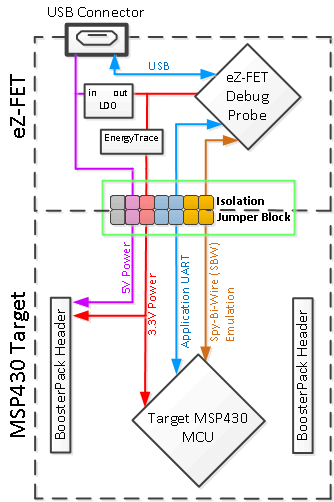SLAU664B February 2016 – August 2017
-
MSP430FR2311 LaunchPad™ Development Kit (MSP‑EXP430FR2311)
- Trademarks
- 1 Getting Started
- 2 Hardware
- 3 Software Examples
- 4 Resources
- 5 FAQ
- 6 Schematics
- Revision History
2.2.3 Emulator Connection: Isolation Jumper Block
The isolation jumper block at jumper J101 allows the user to connect or disconnect signals that cross from the eZ-FET domain into the MSP430FR2311 MCU target domain. This includes eZ-FET Spy-Bi-Wire signals, application UART signals, and 3.3-V and 5-V power.
Reasons to open these connections:
- To remove any and all influence from the eZ-FET emulator for high-accuracy target power measurements
- To control 3-V and 5-V power flow between the eZ-FET and target domains
- To expose the target microcontroller pins for other use than onboard debugging and application UART communication
- To expose the programming and UART interface of the eZ-FET so that it can be used for devices other than the onboard microcontroller
Table 2. Isolation Block Connections(1)
| Jumper | Description |
|---|---|
| GND | Ground |
| 5V | 5-V VBUS from USB |
| 3V3 | 3.3-V rail, derived from VBUS in the eZ-FET domain |
| RXD << | Backchannel UART: The target FR2311 receives data through this signal. The arrows indicate the direction of the signal. |
| TXD >> | Backchannel UART: The target FR2311 sends data through this signal. The arrows indicate the direction of the signal. |
| SBW RST | Spy-Bi-Wire emulation: SBWTDIO data signal. This pin also functions as the RST signal (active low). |
| SBW TST | Spy-Bi-Wire emulation: SBWTCK clock signal. This pin also functions as the TST signal. |
(1) Also see Figure 6.
 Figure 6. eZ-FET Isolation Jumper Block Diagram
Figure 6. eZ-FET Isolation Jumper Block Diagram